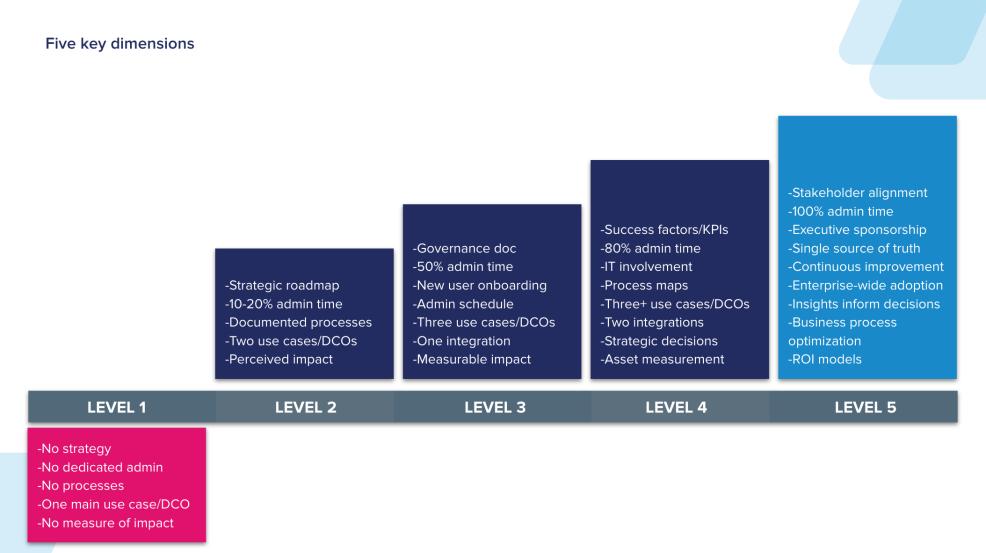
Getting the Most From Your DAM System With Acquia’s Brand Management Maturity Model

Managing your brand to deliver great customer experiences (CX) is no easy task. You need efficient content distribution, effective marketing automation, on-point social media, dependable relationship management, and so much more. A digital asset management (DAM) system helps teams create, organize, publish, and analyze content in today’s complicated marketing environment. It’s the central content hub from which you can deliver top-notch customer experiences.
It’s a good practice to periodically review how your use of DAM technology shapes your brand experiences, but that’s often easier said than done. That’s why we created our Brand Management Maturity Model. This is a tool to support your use of DAM software and to benchmark brand management practices as they relate to DAM across five interconnected dimensions: strategy, people, process, technology, and impact. Virtually no marketing organization enjoys full maturity along all five dimensions. Pursuing this goal, however, will take you a long way toward achieving the brand management success you desire.
Why is brand management maturity worth benchmarking?
Like most companies, you probably use a DAM solution to organize your brand assets to expand into new markets, launch new products or services, and introduce new experiences. The maturity of your brand management practice influences how quickly you can go to market and how efficiently you can drive new revenue.
Using this model regularly will help you understand how your DAM technology use has evolved and articulate future goals. It will help you benchmark your current state and offer a blueprint for how to go to the next level, regardless of your starting point. Once you understand where you are, you can assess how optimizations to your brand management processes can help you:
- Enhance your customer experience
- Drive revenue growth
- Develop new products and services
- Improve speed to market
- Expand into new markets
- And more!
The five dimensions of brand management maturity
Our Brand Management Maturity Model is ultimately a way to improve your return on investment (ROI). We find that there are typically five stages, or levels, of maturity:
Level 1 - Ad hoc
Level 2 - Allocated
Level 3 - Dedicated
Level 4 - Strategic
Level 5 - Distinguished
When assessing your level of maturity, we think five criteria (or dimensions) matter most: strategy, people, process, technology, and impact. While each can be assessed independently, collectively, they speak to an organization’s ability to use DAM for brand management. The implementation of these dimensions can help you level up your maturity.
When the dimensions are implemented and then evolved, their influence becomes more meaningful and impactful. Let’s take a look at how the different phases of each dimension come together across the five levels.

Note: DCOs refer to what we call “desired customer outcomes.”
The first dimension: strategy
Having a clearly defined strategic roadmap is the foundation to brand management success. It not only advances your organizational vision, but also guides continuous improvement across other marketing technology (martech) dimensions. Surprisingly, some marketers don’t take strategy seriously — or if they do, they ignore the steps needed to make their goals a reality.
Moving up the ladder in our model requires initiative. A good place to start is with strategy workshops to facilitate ideas, set goals, and define key performance indicators (KPIs). One of the most important KPIs is consistent use of DAM across teams. A governance document will prove invaluable in achieving this goal, as it defines how the system should be used. If you don’t have one, this governance planning document is a good place to start.
Once you have your governance document in place, share the results with your internal and external stakeholders to create alignment. Finally, ensure your strategy is broadly implemented, review your results, and make changes when needed.
The second dimension: people
Because digital asset management fits hand-in-glove with brand management, proper staffing is vital to brand maturity.
To move from the lowest levels of maturity in terms of staff development, outside coaching can be helpful. A qualified DAM vendor can help define the system maintenance needed on a regular basis. If a small internal team is sharing admin responsibilities, find ways to divide the work, or start a weekly or monthly rotation. You can create a coalition of stakeholders to drive user engagement and identify opportunities for system optimization. HR can assist by making DAM training a part of new employee onboarding. And you can encourage the admin team to join an external user community to learn best practices, share experiences, and gain inspiration.
When combined, these tactics will give you the momentum to achieve your maturity goals and secure executive support — which will ensure you have the financial and strategic resources to continually optimize your management practices.
The third dimension: process
A formalized process for DAM operations can profoundly improve brand management. Yet all too often, enterprises ignore this key discipline.
So how do you go about maturing your processes? If you're at the lower levels of the maturity model, begin by treating your DAM platform as your central source of truth. By avoiding the use of other libraries or storage systems, you'll begin your journey to higher efficiency.
Next, map out common workstreams and roadblocks. Ask for input from every team that has meaningful contact with your DAM system. This will deepen your understanding of how the system is used today and highlight ways it can be improved to meet evolving needs.
Next, create mechanisms for your users to provide continual feedback for site improvements. You should also conduct regular site audits to evaluate the content you have and how it’s used.
As you continue to mature, hold regular training sessions so all users are aware of system changes and enhancements. Create a DAM success roadmap to guide improvements to your strategy and governance plan. Meaningful, data-supported success metrics will help with planning and decision-making. Finally, issue regular companywide communications on updates and successes as they relate to your brand.
The fourth dimension: technology
Brands run more efficiently when their organization’s tech capabilities are used consistently and at capacity. DAM platforms have immense potential to add sophistication to your brand management ... if its functionality is fully leveraged.
The next steps in optimizing your DAM investment via mature brand management practices include creating curated portals for personalized content delivery and using embed codes to facilitate asset deployment across the web. At the highest levels, organizations deploy their DAM capabilities throughout the enterprise and make use of analytics tools to inform decision-making.
Mapping how a DAM platform can interface with other martech solutions is a valuable developmental exercise. Take time to chart how your DAM system can feed data to other content technologies like content management systems (CMS) and work management platforms. By understanding the relationships between DAM and various solutions on the information side (such as product information management, enterprise resource planning, and product lifecycle management), as well as the execution side (including ad networks, web content management, and email service providers), you’ll learn how to use all of your martech capabilities more effectively. Further, because these integrations position the DAM system within your martech stack as the central source of truth, they will support brand consistency across touchpoints and channels.
Another valuable way to use technology to enhance your brand management is through DAM content analytics tools. These tools allow you to better understand who is accessing your content — and when, where, and how it’s being used.
When used effectively, technology can identify top performing assets, improve workflows, maximize asset ROI, and help create a more positive, consistent brand perception.
The fifth dimension: impact
Organizations that are in the early stages of brand maturity have little or no idea how their DAM system impacts their business. They may believe it is beneficial, but they don’t know for sure because they aren’t assessing its effectiveness.
It’s critically important to measure and report on DAM impact. Mature organizations use this data to inform strategic brand decisions and support DAM system optimization.
Sample steps to improve brand management maturity
It’s possible to make great strides in brand maturity, even within the first 12 months. Here’s a sample list of steps to approach it:
- Develop a governance document to outline your purpose and guidelines. You’ll find a governance template here.
- Plan on devoting eight hours a week on DAM maintenance and user engagement, via a dedicated administrator or a team to share tasks.
- Document your process for uploading and tagging new assets as part of your creative workflows.
- Map out your martech stack to identify the role that DAM plays across the content lifecycle in data management, creative workflow, and content operations — all in support of your customer experience.
- Identify two to three KPIs related to content use and another two to three related to platform use. A good DAM system will have analytics tools that make it easy to generate monthly, quarterly, and annual reports.
Putting it all together
Ultimately, brand management maturity matters because it helps you achieve the desired outcomes that likely had you seeking out a DAM solution in the first place. And with our flexible model, you choose the dimensions that matter most to help you get to the level of maturity that is optimal for your company.
If you’re already using DAM technology, check out our on-demand webinar to see the model in action. And if you don’t have a DAM solution yet but want to learn more, request, watch, or click through a demo of our platform, Acquia DAM (Widen).
Note: This article was originally published on Widen.com.



